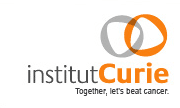
The web supplement to
Bérengère Marty et al.
Breast Cancer Research, 2008



|
|


|
| Frequent PTEN genomic alterations and activated PI3K pathway in basal-like breast cancer |
| Bérengère Marty1, Virginie Maire1, Eléonore Gravier1,2,3,6, Guillem Rigaill1,7, Anne Vincent-Salomon4, Marion Kappler1, Ingrid Lebigot4, Fathia Djelti1, Audrey Tourdès1, Pierre Gestraud3,6, Philippe Hupé3,5,6, Emmanuel Barillot3,6, Francisco Cruzalegui8, Gordon C Tucker8, Marc-Henri Stern9, Jean-Paul Thiery1,10, John A Hickman8 and Thierry Dubois1 |
|
1Département de Transfert, Institut Curie, 26 rue d’Ulm, 75005 Paris, France, 2Département de Biostatistiques, Institut Curie, 26 rue d’Ulm, 75005 Paris, France, 3INSERM U900, Institut Curie, 26 rue d’Ulm, 75005 Paris, France, 4Service de Pathologie, Institut Curie, 26 rue d’Ulm, 75005 Paris, France, 5CNRS UMR144, Institut Curie, 26 rue d'Ulm, 75005 Paris, France, 6Ecole des Mines de Paris, 77300 Fontainebleau, France, 7Unité de Mathématiques et Informatique Appliquées, UMR518, AgroParisTech/INRA, 75005 Paris, France, 8Institut de Recherches Servier, 125 Chemin de Ronde, 78290 Croissy sur Seine, France, 9INSERM U830, Institut Curie, 26 rue d'Ulm, 75005 Paris, France, 10Present address: Institute of Molecular and Cell Biology, 61 Biopolis Drive (Proteos) Singapore 138673. |
|
Introduction: Basal-like (BLCs) and epidermal growth factor receptor 2 overexpressing (HER2+) carcinomas are the subgroups of breast cancers which have the more aggressive clinical behavior. In contrast to HER2+ carcinomas, no targeted therapy is currently available for the treatment of patients with BLCs. In order to discover potential therapeutic targets, we searched for deregulated signaling pathways in human BLCs. Methods: In this study, we focused on the oncogenic phosphatidylinositol 3-kinase (PI3K) pathway in thirteen BLCs, and compared it to a control series of eleven hormonal receptor negative- and grade III- matched HER2+ carcinomas. The two tumor populations were first characterized by immunohistochemistry and gene expression. The PI3K pathway was then investigated by gene copy-number analysis, gene expression profiling and at a proteomic level using reverse phase protein array technology and tissue microarray. The effects of PI3K inhibition pathway on proliferation and apoptosis was further analyzed in three human basal-like cell lines. Results: The PI3K pathway was found to be activated in BLCs and up-regulated compared to HER2+ tumors as shown by a significantly increased activation of the downstream targets Akt and mTOR. BLCs expressed significantly lower levels of the tumor suppressor PTEN and PTEN levels correlated negatively in a significant manner with Akt activity within that population. PTEN protein expression correlated significantly with PTEN DNA copy number and more importantly, reduced PTEN DNA copy numbers were observed specifically in BLCs. Similarly to human samples, basal-like cell lines exhibited an activation of PI3K / Akt pathway and low/lack PTEN expression. Both PI3K and mTOR inhibitors led to basal-like cell growth arrest. However, apoptosis was observed specifically after PI3K inhibition. Conclusion: These data provide insight into the molecular pathogenesis of BLCs and implicate the PTEN-dependent activated Akt signaling pathway as a potential therapeutic target for the management of patients with poor prognosis BLCs. |
| Download data: | ||
| Affymetrix raw files (.CEL) from Marty et al. accepted for publication in Breast Cancer Research. 23 breast tumors (12 basal-like and 11 HER2+ carcinomas). | Get them (.zip) | |
| Affymetrix expression dataset from Marty et al. accepted for publication in Breast Cancer Research. 23 breast tumors (12 basal-like and 11 HER2+ carcinomas). GC-RMA normalization. | Get it (.txt.zip) | |
| Clinical data subtypes (basal-like and HER2+) and grade of the 23 breast tumors from Marty et al. accepted for publication in Breast Cancer Research. | Get it (.txt) |
| Last modified November 26 2008 14:00:28 |